
 |
||||||||||||||
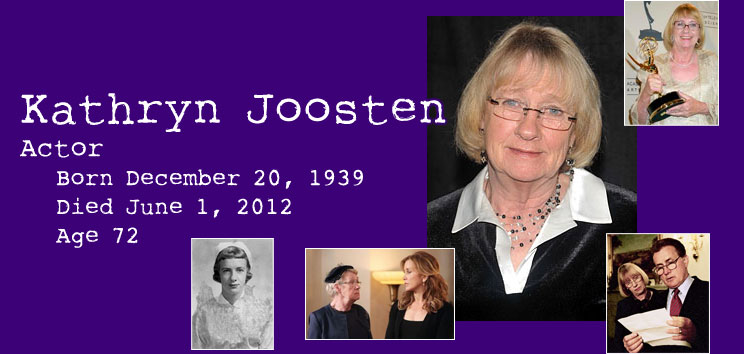 |
||||||||||||||
Matt Hubbard came through with a charming look at a late bloomer. Brad, Dead People Server and Drunkasaskunk get the trio, for a total of 9 points. * * * A young person from a small town longs to be on the stage. After as much success as the limited locale will offer, the next step is to travel to the big city, seeking fame and fortune. It is the beginning of thousands of success stories and millions of heartbreaks. But let us change one adjective. What if the starstruck performer is not a young person? That story is much rarer, and that is Kathryn Joosten's tale. IMDb.com shows us Ms. Joosten's enviable career path, up close and personal. She got a few roles on TV shows while living in Chicago in the 1980s, but it was after becoming a street performer at Walt Disney World in Orlando that she made the decision to try to make her dream come true and become an actress in Hollywood in 1995. At the age of 55. For every idiot optimist who will say that "55 is the new 40" or some other non-mathematical claptrap, let me just say that "post-menopausal is the new post-menopausal." Kathryn Joosten was not one of those ageless wonders. She looked every bit of 55 (and maybe a little bit older) when she was 55. Being a heavy smoker for several decades will do that to you. She was destined to play little old ladies and, as it turned out, TV shows had tons of roles for little old ladies, and she could play the hell out of them. She got six jobs on TV shows in her first year. This probably was not enough to pay all the bills, but it was a damn good start. She worked a lot, almost always on TV, often in comedies. Then she started getting recurring roles, sometimes on shows that tanked like Thanks (a comedy about the Puritans) but, luckily for her, also on successful shows like Dharma & Greg (where she played Claire) and The West Wing, where she played President Bartlet's secretary, Mrs. Landingham. Now the bills were getting paid without a doubt. And not a moment too soon. In 2001, Kathryn Joosten was first diagnosed with lung cancer. Being a heavy smoker for several decades will do that to you. She survived the first bout, but the disease came back in the other lung in 2009, in the middle of her run as nosy neighbor Karen McCluskey on another successful show, Desperate Housewives. (She won two Emmys for playing Karen.) She survived the second bout and even went on The Bold and the Beautiful as herself in 2011 on a "very special episode" devoted to women who had survived cancer. She died from lung cancer at the age of 72. Nowadays, that's not very old. So the story of Kathryn Joosten has two morals: First, your dreams can take you far. Second, they can take you even further if you stop smoking before you start dreaming. — Matthew Hubbard |
||||||||||||||
 |
||||||||||||||
Our old pal Matthew Hubbard jumped at the chance to show his trivia skills. Love this. (Dianagram, Fireball and JTH get 9 points: 8 for the hit plus one for the trio.) * * * Predicting longevity in show business is as much a crap shoot as predicting when people are going to die. In William Goldman's immortal words, "Nobody knows anything." (Except of course for the people at the top of the table in our deadpool year after year. I'm convinced anyone who has finished a year with over 200 points must have some recombinant vulture DNA in their genetic make-up.) The cast of Hogan's Heroes is a perfect example. Bob Crane had a bright future as the guy-next-door on sitcoms, right? Sure, except he was into kinky sex and got killed by someone even weirder than he was. It was sad John Banner died just a few years after the show left the air, but not surprising. After all, Sgt. Schultz was obese. If you want a surprise, consider that Leon Askin (the even fatter Gen. Burkhalter) worked steadily well into his nineties, dying in 2005 at the age of 98. Some deadpooler got a few points when he kicked. Richard Dawson's acting resume after Hogan's Heroes is nearly as sparse as Larry Hovis' or Ivan Dixon's. Hovis had some success as a writer and producer, and Dixon did a lot of TV directing. (Both are dead, by the way. If you want a Hogan's Heroes alum in your line-up next year, you have to go with Robert Clary, the Frenchman who was imprisoned in a concentration camp when he was a kid.) Dawson found success as a game-show celebrity. He was for The Match Game what Paul Lynde was for The Hollywood Squares. In 1976 he became the original host of Family Feud, the last big success for Mark Goodson-Bill Todman Productions. Dawson stopped being the host in 1985 but returned in 1994 after his replacement, Ray Combs, couldn't get the ratings. (Combs later killed himself while hosting Family Challenge on Nickelodeon, and episodes ran for weeks after his death. Like Bob Crane, it was hard to imagine Combs was so dark.) Hosting the Feud obviously helped Dawson get his role as Damon Killian in The Running Man, the Schwarzenegger movie based on one of Stephen King's "Richard Bachman" books. What else can be said about the guy? He was born Colin Lionel Emm in 1932. He was married to the British blonde bombshell Diana Dors (née Diana Marie Fluck) from 1959 to 1966. He met his second wife, Gretchen, in the 1980s when she was a contestant on Family Feud. And then there's Dawson's singing career, if you can call it that. KFJC, a college radio station in the San Francisco Bay Area, had a show called the Silver Throats Special back in the 1980s and 1990s, specializing in actors' and athletes' recordings. You may already be aware of the records William Shatner and Leonard Nimoy put out. You might have heard Sebastian Cabot performing Bob Dylan. Maybe you even heard Muhammad Ali's recording telling kids to fight Mr. Tooth Decay. But have you heard Richard Dawson speak-singing "This is Worth Fighting For"? Be forewarned. It's worse than Shatner. — Matthew Hubbard |
||||||||||||||
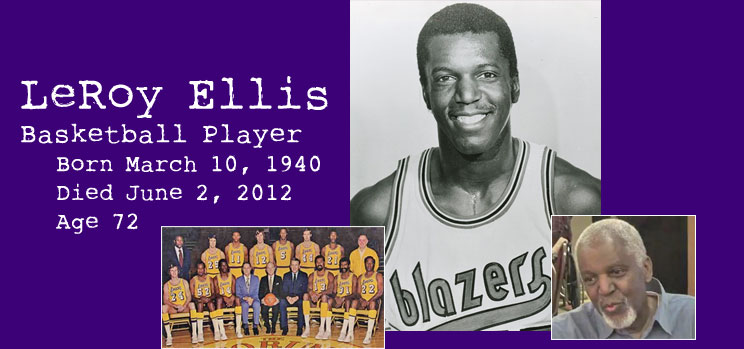 |
||||||||||||||
Thanks, Gerard Tierney, for volunteering and for delighting us with this update. Much appreciated. * * * For most of his long and productive NBA career, the spotlight seemed determined to elude LeRoy Ellis. A 6'10" center from St. John's University, he was the Los Angeles Lakers' first-round draft choice in 1962, one pick ahead of future Celtics Hall of Famer John Havlicek. With the Lakers, Ellis played in the NBA finals three out of four years, losing each time to the Celtics before being banished to Baltimore, where he had his best individual season on the league's worst team. Just as the Bullets were becoming a league power — they would go to the finals the following year — Ellis was claimed in the 1970 expansion draft by upstart Portland. The newly-minted Trail Blazers would win 29 games that season, the second-most ever for an expansion team (by comparison, the 1966-67 Bullets, in their sixth year as a franchise when Ellis arrived, won only 20), and Ellis was a key starter. Early on, he set a team record, tied but never broken, with 26 rebounds in a regulation game. A few nights later he grabbed twelve in one quarter. After a single season, it was back to L.A. and a share of immortality, albeit in a backup role to Wilt Chamberlain, as the Lakers won an unprecedented 69 games, including a record 33-game winning streak, on their way to their first championship in Los Angeles. Alas, the champagne had barely dried when, ten games into the 1972-73 season, Ellis was traded to the winless Philadelphia 76ers, who would fail to win ten games all year en route to the worst record in NBA history. "They could have been 20-0 and I wouldn't have wanted to go to Philly," he said later. "I just didn't like Philadelphia." True to form, the year after Ellis retired, the Sixers played for the title. In 1985, Ellis settled in Portland and began a second, longer career in adult leagues and international Masters competition in which he, the "ultimate ringer," was a dominant force until the age of 67, when he was slowed by spreading prostate cancer. "For a big guy, he was awfully quick. You can never catch him," said former St. John's coach Lou Carnesecca in a statement posted on the university's website. "He spent 14 years in the NBA and you could not catch him, longitudinally. He had a soft touch and was a good rebounder. He was a quiet guy, you never knew he was around. But when he was on the court, you always knew." He's no longer around, but Morris the Cat and I knew his cancer was. The final box score reads 8 points for age and 3 for the duet. Total: 11. — Gerard Tierney |
||||||||||||||
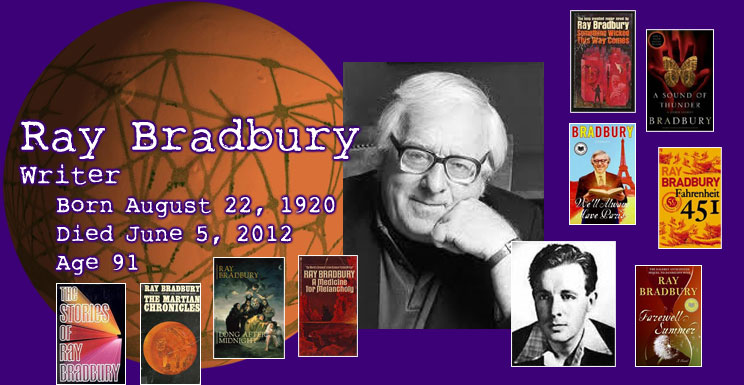 |
||||||||||||||
Eternity Tours, Kathi, Keister Button, Roxanne Wiggs, WEP and Brigid, who wrote this fabulous update while making margaritas for the boys, all get two points for the iconic Sci-Fi Stranger. Thanks again, Brigid. * * * The opening paragraph of the dust-jacket synopsis for one of my very favorite books, Death is a Lonely Business, reads thus: "In this, his first full-length work of fiction since Something Wicked This Way Comes was published more than twenty years ago, Ray Bradbury, master of the modern supernatural, works his magic in an entirely new way — giving us a novel that is at once a loving tribute to the hard-boiled detective genre of Hammett and Chandler and a gently nostalgic evocation of a time and place." And it's true, but it's not the whole story. Nostalgia is the lynchpin on which Bradbury hangs his narratives of the future. Some authors who write science (or speculative) fiction share visions of fantastic worlds brought about by ingenious extrapolation of existing technologies. Bradbury's futures were more comfortably familiar. In his future, astronauts go to Mars and find their bucolic childhood villages transposed to an alien environment. In one of his most famous stories, "All Summer in a Day," the children of a Venusian colony are just like our elementary-school classmates, complete with shy kids and the bullies who prey upon them. However, in Bradbury's stories, because we've strayed so far from home, the stakes are immeasurably higher. That ideal representation of small-town America is a mirage constructed to put the interlopers at ease until the Martians can put them to death and neutralize the threat of colonization. The bullies on Venus don't just steal today's sunshine, they take away the only sunshine anyone will see for years. Is Bradbury trying to send us a message with these stories about sweet sauces masking a deeper rot? I don't think so. Which brings me back to Death is a Lonely Business. More than being a nostalgic romp through gritty noir (and Venice Beach), it's a paean to the writer's way of life. In this story, our protagonist is an unpublished author. He works at his writing every day because he can't help himself. Everything he sees tells him a story. Bradbury will later say this out loud in the introduction to his television series, The Ray Bradbury Theater:
While some wannabe writers get caught up in the dichotomy of "I have nothing to say" vs. "if you have a message, send it Western Union," Bradbury doesn't justify his work. He simply asks us if we'd like to read a story, and because he's been compelled to tell so many, we're sure to find one that we like. He was also close personal buds with Ray Harryhausen — how cool is that?
Watch "The Two Rays" Panel at the 2007 Comic-Con — Brigid |
||||||||||||||
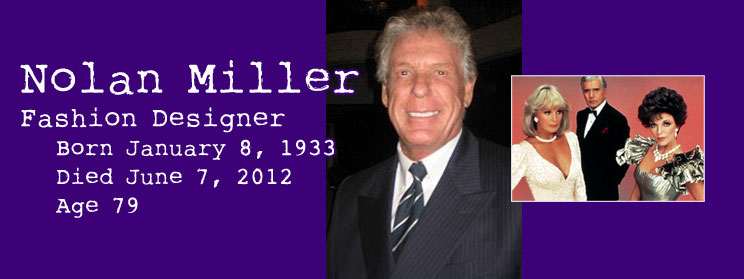 |
||||||||||||||
Nolan Miller, a designer whose dresses raised up the shoulders of Dynasty women, and whose death was confirmed by Joan Collins (of all people) was not gay. He just loved dressing women and squiring them around Hollywood. He was married. OK, so maybe that doesn't prove it, but still. With Dynasty, he had a weekly wardrobe budget of $35,000. Isn't that great? This is what was going on in the world of 1981-1989. (When we all should have been buying brownstones in Brooklyn, by the way.) Sequined dresses, wide-brimmed hats, veils, turbans, and shoulder pads galore. He power-dressed all the ladies who lunched in those series. For most of his career, he worked with Aaron Spelling, even living with that glamorous couple in their chateau for many years, until a dispute over a dress sent him packing. Is that a movie, or what? Get Tori on the line! His success dressing the stars led to a Seventh Avenue career dressing the little people. I believe that was under the label Leslie Fay. It was a really hideous time to be dressing for work, I can tell you from experience. Gerard Tierney and Meadow got the hits. It was Meadow's first hit of the year. They each got 11 points, 8 plus three. — Amelia |
||||||||||||||
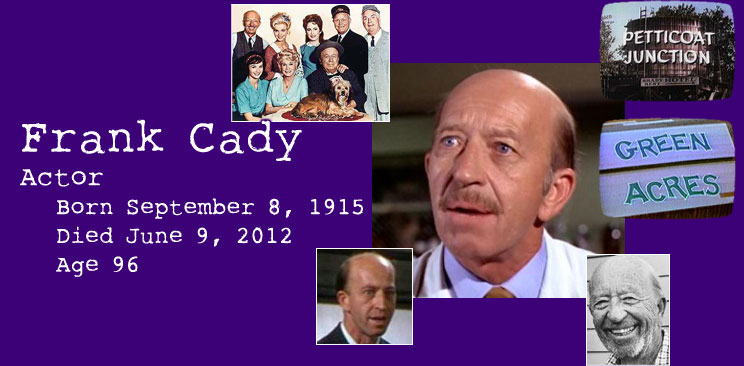 |
||||||||||||||
Character actor Frank Cady was the shopkeeper on two shows, Petticoat Junction and Green Acres. And since I never watched either one, I can't imagine how that happened. They were both set in the fictional town of Hooterville, a fact that would have been sufficient for me to go back to my book instead of turning on the TV. I was a Make Room for Daddy girl. An apartment in Manhattan with a sunken living room was the thing for me. The New York Times obit refers to the colorful, zany folks Cady played straight man to and the fact that at Drucker's he extended credit to those colorful, zany folks. In fairness, he thought the critics were hard on the shows and believed that they were highly sophisticated and timeless. Debatable. But what they were were moneymakers. Cady was a journeyman actor who had a slew of critically acclaimed films and TV shows in his IMDb list, often uncredited or nameless. And even though he was severely typecast for most of his later career, he had this very cool thing to say: " I'm remembered for those shows and not for some pretty good acting jobs I did other times. I suppose I ought to be grateful for that. Because otherwise I wouldn't be remembered at all. I've got to be one of the luckiest guys in the world." Allen Kirshner, Busgal, Eternity Tours, JD, Keister Button, Kixco, Loki, RH Draney, Sarndra and Tim J. watched those shows. They each get two points. — Amelia |
||||||||||||||
 |
||||||||||||||
I asked Bill to write this because ... well ... I thought he would know more about the subject ... * * * There have been many mob rats who have achieved a high level of notoriety for snitching on underworld confederates: Abe "Kid Twist" Reles, Joseph Valachi, Joseph "The Animal" Barboza, Sammy "The Bull" Gravano, Jimmy "The Weasel" Fratianno, and Frank Lucas of American Gangster fame. None, however, was as likable as Henry Hill, who found a cult following based on Ray Liotta's GoodFellas portrayal of him. Besides likability, Hill was seemingly untouchable, because absolutely no one liked the psychotic, murderous Jimmy Burke. Ratting on Burke took a huge load off Brooklyn-based Mafiosi because Burke's desire to murder everyone who was involved in the so-called Lufthansa Heist brought way too much unwanted heat by federal authorities. Paul Vario was considered collateral damage. He was thought to be archaic — a Moustache Pete — a mob guy who disdained drug trafficking, and in the 1970s and '80s there was just too much money to be made from providing heroin, cocaine and marijuana. So Henry Hill got a pass on a mob death sentence, but not on a lifetime of bad choices. That bill, long overdue, was paid in full on June 12th, and Amelia was there, contract in hand, to collect. And this wasn't any two-bit contract. The gorgeous deadpool diva gets eleven points for the hit and an additional five points for getting rid of the body without any help. If Amelia has Frank Lucas on her 2013 deadpool list ... it would be best to avoid her until the smoke clears. — Bill Schenley |
||||||||||||||
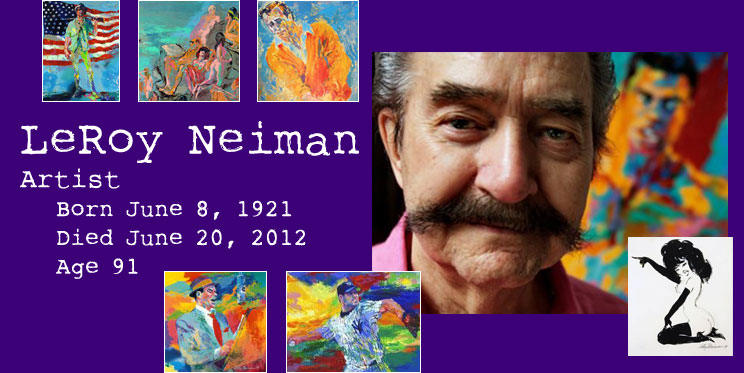 |
||||||||||||||
Bill Schenley writes. * * * All right, it's about time I wrote this LeRoy Neiman deadpool update. I think he died sometime this year — or maybe it was last year — who knows ... LeRoy Neiman was what I call a trendy little painter. You know the type. Patrick Nagel. Thomas Kinkade. Medium-talent schlock dealers. Their marketing skills far outweighed any artistic ability they had. The first time I recall seeing a Neiman painting was Muhammad Ali, or Cassius Clay, standing over a fallen Sonny Liston. I thought it was great. Then I saw Neiman's Willie Shoemaker — on a horse — and it looked suspiciously like Muhammad Ali, or Cassius Clay, standing over Sonny Liston. Nagel painted the same woman 500 times using the same colors and was able to sell it over and over again. Kinkade painted the same fucking cottage using the same colors and was able to sell it over and over again. Neiman was a little different in that he painted something else each time, using the same colors, but always making it look like Muhammad Ali, or Cassius Clay, standing over an OD'd Sonny Liston. And, like Nagel and Kinkade, Nieman was able to sell it over and over again. Frank Sinatra looked like Arnold Palmer, the hideous fucking lion resembled Billie Jean King, Lady Liberty and the Three Tenors could have been a quartet. Rocky could'a been a contending Bullwinkle. What the fuck is wrong with American taste in art? So, like I previously wrote, LeRoy Neiman is dead. Few people got more from a box of eights than LeRoy Neiman. Okay, maybe Patrick Nagel did ... LeRoy used to be 91. Pat Peeve gets a solo worth seven points: two for the hit and five bonus points. He also gets a sincere fucking thank you from me ... — Bill Schenley |
||||||||||||||
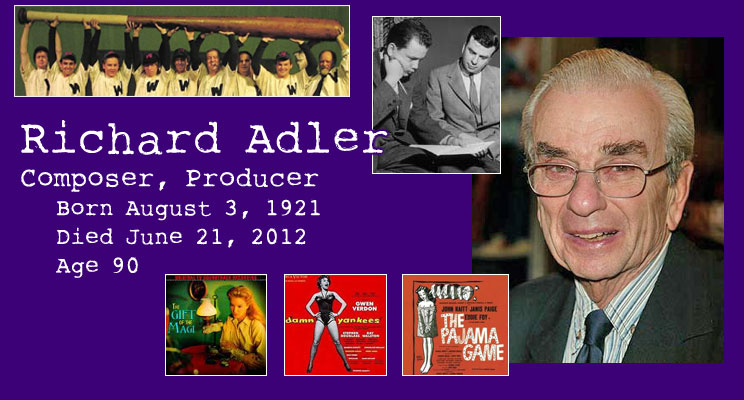 |
||||||||||||||
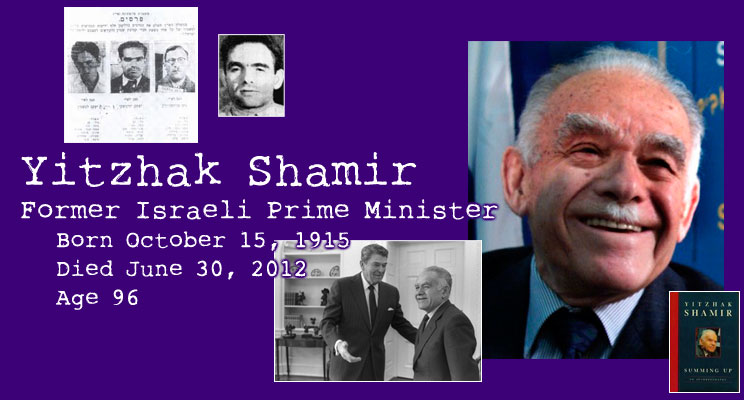 |
||||||||||||||
WEP sent along this strange but charming update for Yitzhak Shamir. It's gotta little English, a little Hebrew and a lot of pizazz. Thanks, WEP. You're the best. # # # If there was any person who I thought had been dead for years, it was Yitzhak Shamir. Even those who did not mix him up with Yitzhak Rabin, the Arafat-handshaking Nobel Peace Prize winner, thought of a political figure of the 1980s. And being a politician in Israel in the 1980s meant to be no candidate for longevity. Mr. Shamir was born in a Russian town, which is now in Belarus, but he went to Palestine in 1935, where he joined the IRGUN, a Jewish military underground organization (which is what we would call a terrorist group). Together with two other chaps, the so-called "Stern Gang," he founded the radical group LECHI (another kind of terrorist group), which organized the assassinations of Walter Guinness and Folke Bernadotte. This underground life qualified Mr. Shamir for the Mossad as well as the Knesset. (The second one is NOT a terrorist group!) He became prime minister in 1983 and again in 1988 but his political legacy was nothing more than a quote: During a conference with Egypt's president Anwar Sadat (yet another Nobel Peace Prize-winning terrorist politician), he shouted out while smiling: "We are in total disagreement!"
Mr. Shamir was ninety-six and nominated by eight teams: Amelia, Another Lurker, Deceased Hose, Gerard Tierney, Grim McGraw, Keister Button, Morris the Cat and The Wiz. This means two points. (At least he had some success.) — WEP |
||||||||||||||

